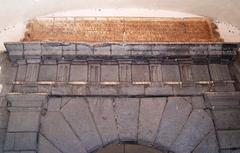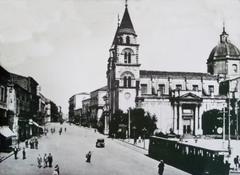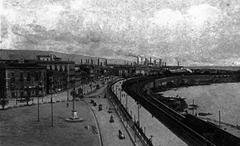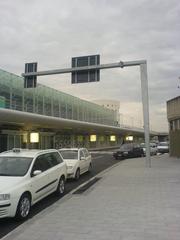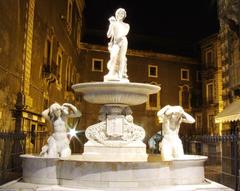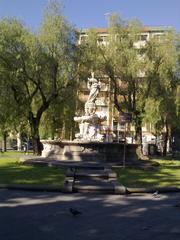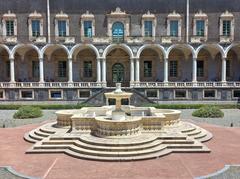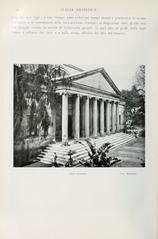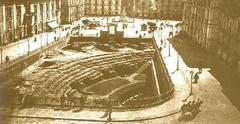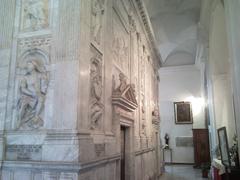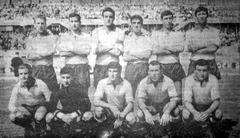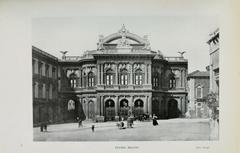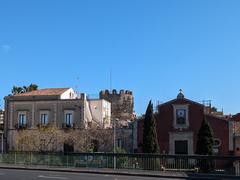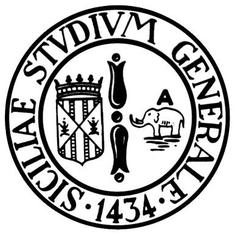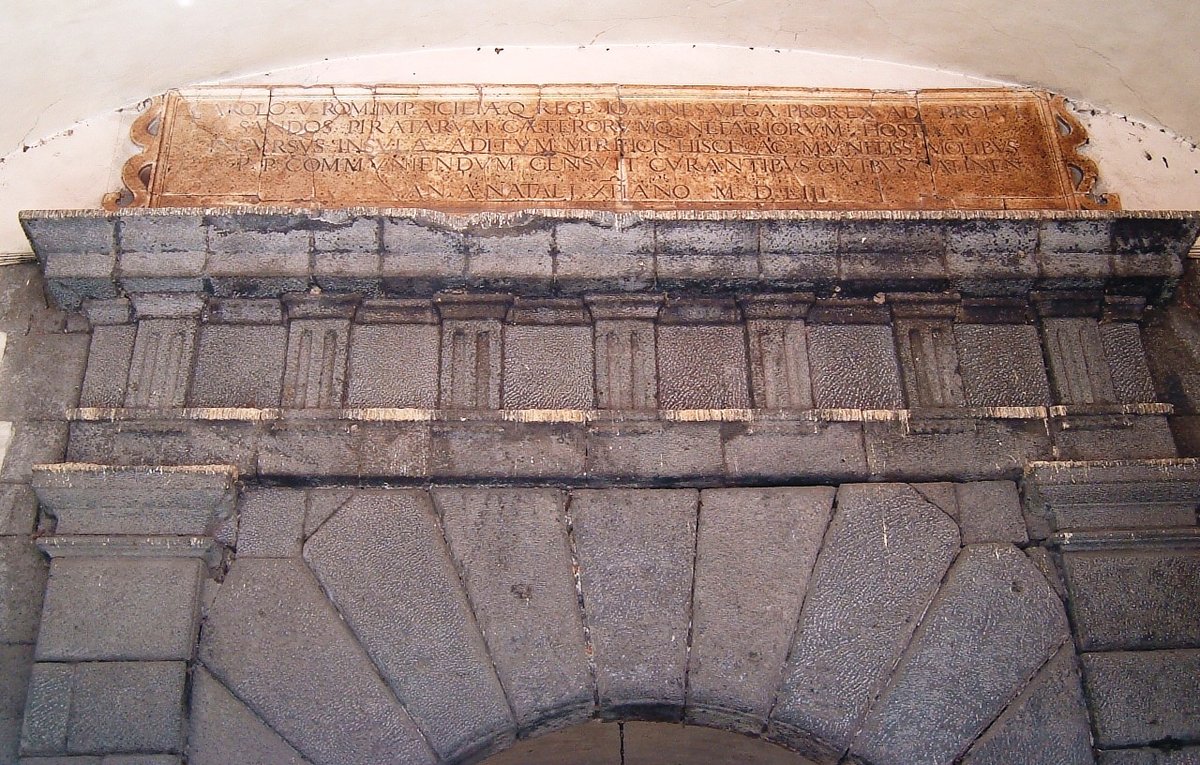
Porta di Carlo V: Visiting Hours, Tickets, and Complete Guide to Catania’s Renaissance Gateway
Date: 14/06/2025
Introduction
Porta di Carlo V is a striking Renaissance monument and the only surviving city gate of Catania’s once-formidable 16th-century fortifications. Built of volcanic lava stone and adorned with classical motifs, it stands as a testament to the city’s resilience, architectural ingenuity, and historical significance as a key Mediterranean stronghold under Spanish rule. Located at the entrance to the bustling Pescheria fish market and a short stroll from Piazza Duomo, the gate embodies both Catania’s turbulent past and vibrant present.
This guide provides a comprehensive overview of Porta di Carlo V, including its history, architectural features, visitor information, practical travel tips, and its role in contemporary urban life. Whether you’re a history enthusiast, architecture lover, or simply eager to explore Catania’s cultural heart, this article will help you experience one of Sicily’s most captivating landmarks to the fullest.
For further background, refer to local tourism authorities and dedicated historical resources (NotizieCatania.it; CityMapSicilia; Wikipedia).
Table of Contents
- Introduction
- Historical and Political Context
- Construction and Architectural Features
- Porta di Carlo V: Survival Through Disaster
- Urban Role and Cultural Significance
- Visiting Porta di Carlo V: Hours, Tickets, and Accessibility
- Travel Tips and Nearby Attractions
- FAQ
- Visuals and Media
- Preservation and Community Engagement
- Conclusion and Call to Action
- References
Historical and Political Context
The origins of Porta di Carlo V are rooted in the turbulent 16th century, when Catania was governed as part of the Spanish Empire under Emperor Charles V. The frequent threat of Ottoman raids and pirate incursions along the Sicilian coast exposed the inadequacy of Catania’s medieval walls. In response, Charles V and Viceroy Juan de Vega launched an ambitious modernization of the city’s defensive perimeter, commissioning the renowned military architect Antonio Ferramolino.
Ferramolino’s design for the city’s new fortifications included eleven bastions and seven gates, all constructed primarily from locally sourced lava stone. Porta di Carlo V, or Porta dei Canali, was strategically placed to both control access from the port and symbolize imperial authority. The city walls and bastions were designed to withstand the era’s evolving military technologies, particularly artillery (NotizieCatania.it).
Construction and Architectural Features
Distinctive Renaissance Design
Porta di Carlo V exemplifies Renaissance military architecture in Sicily. The gate is constructed from large, squared lava stone blocks—providing structural durability and a visually striking contrast against the city’s lighter Baroque facades. Its main arch is flanked by classical pilasters with Tuscan capitals and topped by a metopal frieze, drawing inspiration from ancient Roman forms (CityMapSicilia; Wikipedia).
Above the arch, a prominent marble plaque inscribed in Latin commemorates Charles V’s efforts to fortify the city, emphasizing Catania’s strategic importance. Uniquely, some stonework may have been repurposed from earlier monuments—a practice known as spolia, common during the Renaissance (Wikipedia).
Integration with the Urban Fabric
Originally, Porta di Carlo V served as the main southern entrance to Catania, linking the port, Amenano River, and city center. After the 18th-century reconstruction following devastating natural disasters, the gate was partially incorporated into the Baroque Seminario dei Chierici, which now envelops the structure but preserves its Renaissance core (Wikipedia).
Defensive and Civic Roles
The gate was a critical element in the city’s defense system, controlling movement and facilitating trade through its proximity to the Amenano River and the bustling fish market. Unlike later ceremonial gates, Porta di Carlo V was designed for utility and protection, reflecting a period when military security was paramount (GruppoWeekend).
Porta di Carlo V: Survival Through Disaster
Catania’s fortifications, including its gates and bastions, suffered severe damage from Mount Etna’s eruption in 1669 and the great earthquake of 1693, which destroyed much of the medieval and Renaissance city (NotizieCatania.it; Wikipedia). While most gates were lost, Porta di Carlo V survived, largely thanks to its robust construction and later integration into new buildings. Today, it stands as a rare, tangible link to the city’s Renaissance fortifications and defensive strategies.
Urban Role and Cultural Significance
Gateway to the Historic Center
Porta di Carlo V marks the transition from Catania’s historic core to the vibrant Pescheria fish market—a hub of local commerce and culture (CityMapSicilia). Its location at Piazza Pardo continues to define the movement of people and goods, just as it did centuries ago.
Symbol of Resilience and Identity
The gate’s endurance through centuries of upheaval has made it a symbol of Catania’s resilience and adaptability. It features prominently in local festivals and processions, especially during the Festa di Sant’Agata, when the streets around the gate come alive with celebrations (Isla Guru). Its image is used in educational materials, tourism campaigns, and even business branding, anchoring Catania’s identity in its architectural heritage.
Contrast with Baroque Monuments
Porta di Carlo V stands apart from Catania’s predominantly Baroque monuments, offering a rare glimpse into the city’s Renaissance and pre-Baroque urban landscape (TravelingItalian).
Visiting Porta di Carlo V: Hours, Tickets, and Accessibility
- Location: Piazza Pardo, 95131 Catania, Italy
- Visiting Hours: The gate is an open-air monument, accessible 24/7 as part of the public cityscape (CityMapSicilia; GoAskALocal).
- Tickets: There is no entrance fee or ticket required to visit Porta di Carlo V.
- Accessibility: The surrounding area is generally flat and paved, suitable for wheelchair users. However, during peak fish market hours, the area may be crowded and ground surfaces somewhat uneven. Assistance may be helpful for visitors with limited mobility.
- Guided Tours: Many local tour operators feature Porta di Carlo V within historical walking tours, often combined with other city gates, Castello Ursino, and Piazza Duomo (GoAskALocal).
- Getting There: The gate is a short walk from Piazza Duomo and Via Etnea. Public buses and taxis are available for longer distances; parking in the historic center is limited, so consider using public transportation or walking (Voyage Tips).
Travel Tips and Nearby Attractions
- Best Time to Visit: Early morning and late afternoon provide the best lighting for photography and fewer crowds, especially if you want to experience the fish market at its most atmospheric (Wanderlog).
- Nearby Attractions:
- Pescheria Fish Market: A lively, traditional fish market just beyond the gate.
- Piazza Duomo: Catania’s main square, home to the Cathedral of Saint Agatha and the Elephant Fountain.
- Via Etnea: The city’s principal avenue, lined with shops and Baroque palaces.
- Castello Ursino: A medieval fortress and museum located a short walk away.
- Local Etiquette: Be polite and ask for permission before photographing market vendors or stalls.
- Safety: The area is generally safe, but always watch your belongings in crowded market conditions.
- Accessibility: Streets are paved, but can be uneven; wear comfortable shoes.
FAQ
Q: Is there an entrance fee to visit Porta di Carlo V?
A: No, the gate is freely accessible at all times as part of the city’s public space.
Q: What are the best times to visit the gate and fish market?
A: Early mornings, especially on market days, offer the most authentic experience and best photo opportunities.
Q: Are guided tours available?
A: Yes, many local guides include Porta di Carlo V in their itineraries through the historic center (GoAskALocal).
Q: Is the site accessible for visitors with disabilities?
A: Most of the area is accessible, but crowds and uneven surfaces during market hours may pose challenges.
Q: Can I photograph the gate and market?
A: Yes, but always ask vendors before photographing their stalls.
Visuals and Media
High-quality images of Porta di Carlo V are available on tourism platforms and local heritage sites. Optimized images with descriptive alt text—such as “Porta di Carlo V Renaissance gate in Catania”—are recommended for accessibility. Interactive maps and virtual tours are also available, providing context and route planning for your visit.
Preservation and Community Engagement
Porta di Carlo V is protected as a cultural heritage site. Local authorities and heritage organizations regularly maintain the gate, organize educational activities, and hold special open days to foster appreciation of Catania’s historic architecture (NotizieCatania.it). Its integration with the daily rhythms of the Pescheria market ensures the gate remains a living monument—an active participant in the city’s ongoing story.
Conclusion and Call to Action
Porta di Carlo V stands as a powerful symbol of Catania’s endurance, architectural brilliance, and rich urban life. As the only remaining Renaissance gate, it offers a direct, tangible connection to a pivotal era in Sicilian and Mediterranean history. Whether passing through as part of your daily routine, joining a guided tour, or exploring independently, a visit to Porta di Carlo V is an essential part of experiencing Catania’s unique spirit.
Plan your visit today—explore the vibrant market, admire the Renaissance architecture, and immerse yourself in the living history of this extraordinary Sicilian city.
Download the Audiala app for guided tours, interactive maps, and the latest updates on Catania’s historical sites, including Porta di Carlo V. Follow us on social media for more travel inspiration and insider tips.
For official updates and more visitor information, see the Catania City Tourism Page.
References
- Visiting Porta di Carlo V: History, Tickets, Hours, and Catania’s Historical Sites, 2025, NotizieCatania.it (NotizieCatania.it)
- Porta di Carlo V in Catania: Visiting Hours, Tickets, and Historical Significance of this Renaissance Gateway, 2025, CityMapSicilia & Wikipedia (CityMapSicilia; Wikipedia)
- Visiting Porta di Carlo V: Hours, Tickets & Exploring Catania’s Historic Renaissance Gate, 2025, Notizie Catania & Voyage Tips & Isla Guru (Notizie Catania; Voyage Tips; Isla Guru)
- Porta di Carlo V in Catania: Visiting Hours, Tickets, and Complete Historical Guide, 2025, CityMapSicilia & Wikipedia & GoAskALocal (CityMapSicilia; Wikipedia; GoAskALocal)
